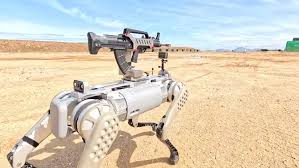
The Chinese military has unveiled a new and controversial addition to its arsenal: rifle-mounted robot dogs. This development comes amid ongoing advancements in robotics and artificial intelligence, where such technologies are increasingly being repurposed for military and security applications.
According to a report from CNN, the Chinese military showcased one of these rifle-equipped robot dogs during recent military drills with Cambodia. The robot dog, demonstrated in a video released by state broadcaster CCTV, is capable of various movements such as walking, hopping, lying down, and moving backwards, all while being controlled by a remote operator.
Soldiers involved in the drills highlighted the potential of these robot dogs in urban combat operations, where they can replace human members to conduct reconnaissance, identify enemies, and strike targets. The video presentation emphasized the robot dog as part of China’s “variety of intelligent unmanned equipment.”
This is not the first time such technology has been showcased by China. Similar rifle-armed robot canines were featured in a joint exercise involving multiple Southeast Asian militaries last year. The US Air Force also demonstrated robot dogs in its Advanced Battle Management System in 2020.
The military drill where the robot dog was unveiled, named ‘Golden Dragon,’ marks the largest-ever joint military exercise between China and Cambodia. Spanning 15 days from May 16 to May 30, the exercise includes a range of activities such as live-fire drills, anti-terrorism operations, and humanitarian rescue simulations. It involves an array of military assets, including warships, helicopters, armoured vehicles, and tanks.
While the unveiling of rifle-mounted robot dogs showcases the cutting-edge capabilities of modern military technology, it also raises ethical and strategic questions. The use of such machines in combat scenarios introduces new considerations regarding autonomy, accountability, and the escalation of armed conflicts. As these technologies continue to evolve, discussions around their regulation and responsible use become increasingly important on the global stage.
Sources By Agencies


